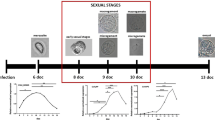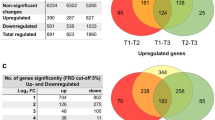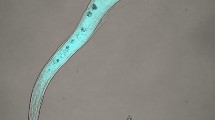Abstract
The bovine lungworm Dictyocaulus viviparus is one of the most important parasites in grazing cattle. However, not much is known about morphology and molecular aspects of sexual maturation occurring during development of preadult larvae (L5) to adults. Since studies in the pulmonary compartments are infeasible, an in vitro cultivation method was established. The study was conducted with L5 during in vitro cultivation, assessing longitudinal growth and sexual maturation. Best results were achieved with RPMI-1640 medium with l-glutamine, 50% fetal bovine serum, amphotericin B (0.25 mg/ml), penicillin (10,000 U/ml), and streptomycin (10 mg/ml) at 39°C and 5% atmospheric CO2. During cultivation, individuals grew from an average length of 4.64 to 9.88 mm independent of their density per setup. Regarding sexual maturation, female individuals started to lay eggs, whereas the testes of male individuals were filled with spermatozoa. Consequently, adult female and adult male worms developed. However, no copulation was observable and eggs did not embryonate. Development was further investigated by quantitative real-time PCR transcriptional analysis of major sperm protein (msp) and vitellogenin (vit) representing male and female sexual development, respectively. Male msp transcription peaked after 5 days of cultivation [corresponding to 20 days post infection (dpi)] and decreased gradually afterwards. Female vit transcription showed the highest rate after 15 days of cultivation (30 dpi), however it never reached the transcription rate in female adults isolated from the host. All in all, the present study gives not only insights into morphological differentiation but provides data lightening molecular aspects of sexual maturation in D. viviparus.






Similar content being viewed by others
References
Baermann G (1917) Eine einfache Methode zur Auffindung von Ankylostomum-(Nematoden)-Larven in Erdproben. Geneeskd Tijdschr Ned Indie 57:131–137
Boag PR, Newton SE, Hansen NP, Christensen CM, Nansen P, Gasser RB (2000) Isolation and characterization of sex-specific transcripts from Oesophagostomum dentatum by RNA arbitrarily-primed PCR. Mol Biochem Parasitol 108:215–224
Bos HJ, Panhuijzen J (1982) Development of larval stages of Dictyocaulus viviparus in vitro. Mol Biochem Parasitol (Suppl):159
Bos HJ, Beekman J (1985) Serodiagnosis of lungworm infection in calves using ELISA. Dev Biol Stand 62:45–52
Brandt BW, Zwaan BJ, Beekman M, Westendorp RGJ, Slagboom PE (2005) Shuttling between species for pathways of lifespan regulation: a central role for the vitellogenin gene family? Bioessays 27:339–346
Coles GC (2001) The future of veterinary parasitology. Vet Parasitol 98:31–39
Cottee PA, Nisbet AJ, Boag PR, Larsen M, Gasser RB (2004) Characterization of major sperm protein genes and their expression in Oesophagostomum dentatum (Nematoda: Strongylida). Parasitology 129:479–490
Cantacessi C, Zou FC, Hall RS, Zhong W, Jex AR, Campbell BE, Ranganathan S, Sternberg PW, Zhu XQ, Gasser RB (2009) Bioinformatic analysis of abundant, gender-enriched transcripts of adult Ascaris suum (Nematoda) using a semi-automated workflow platform. Mol Cell Probes 23:205–217
Cantacessi C, Gasser RB, Strube C, Schnieder T, Jex AJ, Hall RS, Campbell BE, Young ND, Ranganathan S, Sternberg PW, Mitreva M (2011) Deep insights into Dictyocaulus viviparus transcriptomes provides unique prospects for new drug targets and disease intervention. Biotechnol Adv 29:261–271
Divina BP, Wilhelmsson E, Mattsson JG, Waller P, Höglund J (2000) Identification of Dictyocaulus spp. in ruminants by morphological and molecular analyses. Parasitology 121:193–201
Douvres FW, Lucker JT (1958) The morphology of the parasitic stages of the cattle lungworm, Dictyocaulus viviparus, in experimentally infected guinea pigs. J Parasitol 44:28–29
Fabian TJ, Johnson TE (1995) Identification genes that are differentially expressed during aging in Caenorhabditis elegans. J Gerontol A Biol Sci Med Sci 50:B245–B253
Freitas TC, Jung E, Pearce EJ (2007) TGF-beta signaling controls embryo development in the parasitic flatworm Schistosoma mansoni. PLoS Pathog 3:e52
Hawdon JM, Schad GA (1990) Serum-stimulated feeding in vitro by third-stage infective larvae of the canine hookworm Ancylostoma caninum. J Parasitol 76:394–398
Hawdon JM, Volk SW, Rose R, Pritchard DI, Behnke JM, Schad GA (1993) Observations on the feeding behaviour of parasitic third-stage hookworm larvae. Parasitology 106(Pt 2):163–169
Joachim A, Ruttkowski B, Daugschies A (2001) Comparative studies on the development of Oesophagostomum dentatum in vitro and in vivo. Parasitol Res 87:37–42
Kapp K, Knobloch J, Schüßler P, Sroka S, Lammers R, Kunz W, Grevelding CG (2004) The Schistosoma mansoni Src kinase TK3 is expressed in the gonads and likely involved in cytoskeletal organization. Mol Biochem Parasitol 138:171–182
Kimble J, Sharrock WJ (1983) Tissue-specific synthesis of yolk proteins in Caenorhabditis elegans. Dev Biol 96:189–196
Knobloch J, Beckmann S, Burmeister C, Quack T, Grevelding CG (2007) Tyrosine kinase and cooperative TGFβ signaling in the reproductive organs of Schistosoma mansoni. Exp Parasitol 117:318–336
Kunz W (2001) Schistosome male-female interaction: induction of germ-cell differentiation. Trends Parasitol 17:227–231
Lat-Lat H, Sani RA, Hassan L, Sheikh-Omar AR, Jeyabalan S, Hishammfariz M, Rohani K, Azlan E, Ramli P (2010) Lungworm of cattle in Malaysia. Trop Biomed 27:236–240
Matyash V, Geier C, Henske A, Mukherjee S, Hirsh D, Thiele C, Grant B, Maxfield FR, Kurzchalia TV (2001) Distribution and transport of cholesterol in Caenorhabditis elegans. Mol Biol Cell 12:1725–1736
McKeand JB, Knox DP, Duncan JL, Kennedy MW (1995) Protective immunisation of guinea pigs against Dictyocaulus viviparus using excretory/secretory products of adult parasites. Int J Parasitol 25:95–104
Miller MA, Nguyen VQ, Lee MH, Kosinski M, Schedl T, Caprioli RM, Greenstein D (2001) A sperm cytoskeletal protein that signals oocyte meiotic maturation and ovulation. Science 291:2144–2147
Mörck C, Pilon M (2006) C. elegans feeding defective mutants have a shorter body length and increased autophagy. BMC Dev Biol 6:39
Nisbet AJ, Gasser RB (2004) Profiling of gender-specific gene expression for Trichostrongylus vitrinus (Nematoda: Strongylida) by microarray analysis of expressed sequence tag libraries constructed by suppressive-subtractive hybridisation. Int J Parasitol 34:633–643
Panuska C (2006) Lungworms of ruminants. Vet Clin North Am Food Anim Pract 22:583–593
Ploeger HW, Eysker M (2000) Simulating Dictyocaulus viviparus infection in calves: the parasitic phase. Parasitology 120(Suppl):S3–S15
Rose JH (1973) The development in vitro of some gastro-intestinal nematodes of sheep, cattle and pigs. Res Vet Sci 14:326–333
Stringfellow F (1986) Cultivation of Haemonchus contortus (Nematoda: Trichostrongylidae) from infective larvae to the adult male and the egg-laying female. J Parasitol 72:339–345
Strube C, Buschbaum S, Wolken S, Schnieder T (2008) Evaluation of reference genes for quantitative real-time PCR to investigate protein disulfide isomerase transcription pattern in the bovine lungworm Dictyocaulus viviparus. Gene 425:36–43
Strube C, Buschbaum S, Schnieder T (2009) Molecular characterization and real-time PCR transcriptional analysis of Dictyocaulus viviparus major sperm proteins. Parasitol Res 104:543–551
Urquhart GM, Jarrett WFH, McIntyre WIM (1973) Helminth diseases of cattle, sheep and horses in Europe. Bovine dictyocauliasis: pathology, clinical signs, epidemiology, treatment and control. In Proceedings of workshop held at Veterinary School of University of Glasgow. 1973:23–30
von Samson-Himmelstjerna G, Rickling S, Schnieder T (1998) Improved in vitro cultivation of larvae of the bovine lungworm Dictyocaulus viviparus. Parasitol Res 84:682–684
von Samson-Himmelstjerna G, Schnieder T (1999) Morphology of inhibited larvae of the bovine lungworm Dictyocaulus viviparus. J Helminthol 73:79–83
Ward S, Klass M (1982) The location of the major protein in Caenorhabditis elegans sperm and spermatocytes. Dev Biol 92:203–208
Wood IB, Amaral NK, Bairden K, Duncan JL, Kassai T, Malone JB Jr, Pankavich JA, Reinecke RK, Slocombe O, Taylor SM, Vercruysse J (1995) World Association for the Advancement of Veterinary Parasitology (W.A.A.V.P.) second edition of guidelines for evaluating the efficacy of anthelmintics in ruminants (bovine, ovine, caprine). Vet Parasitol 58:181–213
Acknowledgments
The authors want to thank Anja Heckeroth from Intervet Innovation GmbH, Schwabenheim, for kindly providing the PNGM medium.
Author information
Authors and Affiliations
Corresponding author
Rights and permissions
About this article
Cite this article
Laabs, EM., Schnieder, T. & Strube, C. In vitro studies on the sexual maturation of the bovine lungworm Dictyocaulus viviparus during the development of preadult larvae to adult worms. Parasitol Res 110, 1249–1259 (2012). https://doi.org/10.1007/s00436-011-2622-y
Received:
Accepted:
Published:
Issue Date:
DOI: https://doi.org/10.1007/s00436-011-2622-y




